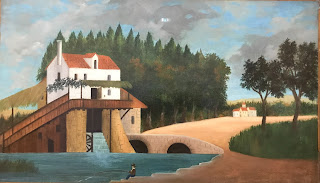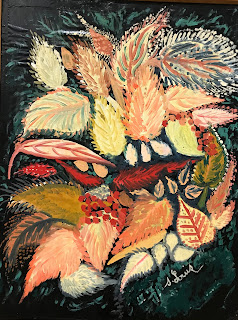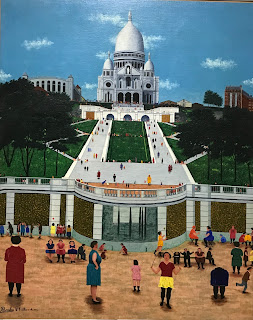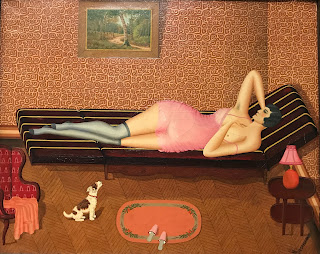LOTS NEW TO LEARN ABOUT...
It had been well over a year since I had gone to VILLENEUVE D’ASCQ for a temporary exhibition at the LAM. It was Modigliani. There hadn’t really been too much that I wanted to see since. But this was a must. A collection. I really like visiting such exhibitions as I wonder where the collector got his idea and why did he take such an interest in the works we will see. The exhibition was called « From Picasso to Seraphine »
Seraphine’s work I knew. What of course I was expecting to see were many
more Picasso’s and certainly less of the « modern primitives »
This a little more about Uhde taken from Wikipedia.
So, this was the first painting…
If you can see or tell who the artist, you will be better than me. Raoul Dufy (1877-1953). Although he was part of the Fauve movement, I remember him for his seaside paintings, Le Havre for instance. But here with « The Cavalier » he seems to have been marked by the cubists and Paul Cézanne. Uhde followed Dufy until 1914 but the paintings he bought were confiscated by the Germans during the 1st world war.
As you know, I am not a still life lover but this vase of flowers really caught my eye. Perhaps it’s the association of colours and background behind the leaves or rather the pot plant on the left which seems to be like a fan behind the vase.
Here too began the first discovery of new names. August Herbin (1882-1960). He was a French painter of modern art. Best known for his Cubist and abstract paintings consisting of colourful geometric figures. He co-founded the groups Abstraction-Création and Salon des Réalités Nouvelles which promoted non-figurative abstract art.
Although I had vaguely heard about the Salon des Réalités, everything else was new.
The following portrait of Erich Kurt Muhsam is also an example of fauvism for me. As for the man himself, he was a German-Jewish antimilitarist anarchist essayist, poet and playwright emerging at the end of World War.
Now I fall on the first Picasso. (1881-1973) painted in 1908-09. Very much the cubist period and this, interested Uhde. It was however, the only Picasso in the exhibition. Had the others been confiscated?
The paintings which followed were by Braque (1882-1963). Uhde apparently was overwhelmed by Braque’s work. He was one of the first collectors alongside Dutilleul and Kahnweiler to purchase the cubists. This was in 1910 and that was the same year that Uhde met Picasso.
Another new name. Serge Charchoune (1888-1975) Russian this time around although he come to Paris in 1912. Took refuge in Spain during the 1st world war. He was struck by the Mozarabe art which combined Christian and ornamental style. I found this painting original in it’s technique for that period and it stood out next to the other cubist paintings on view.
We have come across Amédée Ozenfant (1886-1966). He too was a cubist painter and with Le Corbusier, he founded another movement which we don’t hear about too much today, the Purist movement.
Sonia Delaunaunay (1885-1979) (You saw above that she was married to Udhe in 1908 but divorced. When she discovered his homosexuality, she lived her own life and married Robert Delaunay in 1910.)
I have always liked her work but this painting is very different from her usual cubist and strong in colour images
The two portraits too were very strong.
Henri Rousseau, called Le Douanier was autodidact. Udhe was impressed by his style (even if he was criticised by many other artists for his rather clumsy work). Uhde liked his paintings because of it’s very personal touch. Quite an anecdote - Uhde organised a first man show for Rousseau in 1908 but forgot to indicate the address of his gallery on the invitation. As you can imagine, the exhibition as a total disaster!
Now we turn to Seraphine. From 1912, Uhde went to Senlis as often as he could to get away from the Paris bustle and find peace for his other passion, writing. One day when he was visiting a neighbour, he was taken aback by a still life of apples that looked practically real. He discovers then that this painting had been done by his housekeeper. She had been painting for quite a number of years already and using ripoliné paint, a form of lacquer which is a domestic product rather than a paint.
Later Seraphine tells Uhde that an angel or the Virgin Mary gave her the order to paint when she was inside the Senlis Cathedral. This was at the beginning of the 1st war when Uhde had to return to Germany. All his goods and chattels remained in Senlis but were scattered and the paintings he had bought from Seraphine were never recovered. Probably lost.
When he became a postal controller in Frankfort during the war, Udhe met a young painter, Helmut Kolle. They became lovers and Udhe became his sponsor. They returned to Paris together in 1924 where he presented Kolle’s work - principally focused on the masculine body. Sailors, jockeys, boxers…all the sports that Kolle had wanted to participate in but because of his poor health, was unable to do so. Apparently Kolle was also rather physchologically disturbed so in order to protect him, Udhe moved with Kolle’s sister to Chantilly where they lived until Kolle died in 1933
In 1927, Udhe also revisited Senlis when he finds Seraphine still painting.
This painting, I also thought was by Seraphine. But no. André Bauchant (1873-1958) A French 'naïve' painter. He is known mostly as a painter of flowers and of landscape compositions with figures which were often informed by mythology and classical history. As I began to look at his work more closely, I was frankly amazed how varied it was. This perhaps is what appealed to Udhe. These painters had their own reality and believed in it.
In 1927 Uhde launches a movement called the Artists of Sacré Coeur. They are all unknown. Uhde singles them out as they represent the world as their « real » world. Sometimes as you will see, the paintings are strange with symmetric effects.
The names meant nothing to me. For instance, René Rimbert (1896-1991) - Over the course of his 60-year career, Rimbert produced only 276 paintings and his work is very rarely accessible to the public . The little I saw seemed to be surrealist even if there was a cubist effect
Camille Bombois(February 3, 1883 – June 6, 1970) was also a French naïve painter especially noted for paintings of circus scenes. I can hardly say that this one is a circus scene but it is definitely naive.
Nor a painting of water lilies…
Nor these either....
As Louis Vivin (1861-1936) was a Postal Manager, he was unable to dedicate himself full time to painting until he retired in 1922. Udhe discovered him and often spent time watching him paint. He worked from post cards and did quite a bit of engraving too. A strange effect.
Another gallery and more names…André Lanskoy (1928-1930), was a Russian painter and printmaker who worked in France. He is associated with the School of Paris and Tachisme, an abstract painting movement that began during the 1940s. I do know his name but would not have recognised his work.
Now Dominique Peyronnet (1872-1943). First of all, he worked in printing where he specialised in colour lithography. He too developed his own style which seems to be very precise even « tidy! ».
Jean Deyrolle (1911-1917). I found his work fascinating. Once again, a break away from the usual cubist style and to something which seems to be between realist and abstract. He was one of Udhe’s favourite painters whom he discovered in 1945.
During the second work war, Udhe stayed in France but was very nervous about the Nazis. He lost his nationality in 1939, probably because of his homosexuality and his written work which criticised the German regime. He lived in the South of France and stored a part of his collection in security. However, his flat was requestioned by the Germans and his collection confiscated by the Gestapo.
For Udhe there was no contradiction in his choice of artists. Cubists, Modern Primitifs, abstract which were all looking in their way for an « invisible reality ».
This had been a wonderful moment - and yes, the hours had flown by.
Wilhem Uhde was a German art collector and critic, and was one of the first supporters of cubism before fighting for the recognition of those he termed the "modern primitives". By following his progression, from his meeting with Picasso through to his discovery of Séraphine Louis, the LaM modern art museum was to show a selection of works from major public and private collections in France and abroad.This is more or less what I found on Internet. The LaM home page is not translated into English. Very strange, as Lille, the largest city close to Villeneuve is virtually the centre of « Europe ». An hour from London in the Eurostar, Brussels, Amsterdam, and Paris.
Seraphine’s work I knew. What of course I was expecting to see were many
more Picasso’s and certainly less of the « modern primitives »
This a little more about Uhde taken from Wikipedia.
He studied law in Dresden but switched to art history, before moving to Paris in 1904. He purchased his first Picasso in 1905, and was one of the first collectors of the Cubist paintings of Pablo Picasso.I found his background fascinating. He was too a very handsome man.
Uhde and Sonia Terk married in 1908 (London), reportedly a marriage of convenience which masked his homosexuality. They divorced 1910 and Terk married Robert Delaunay.
At the outbreak of World War I, many German nationals living in France had their possessions sequestered by the French state. As a result, Uhde's collection (including works by Georges Braque, Raoul Dufy, Juan Gris, Auguste Herbin, Marie Laurencin, Fernand Léger, Jean Metzinger, Pablo Picasso, Jean Puy and Henri Rousseau) was confiscated in 1914 and sold by the government in a series of auctions at the Hôtel Drouot in 1921.
From 1919-1920, Uhde worked with Helmut Kolle and lived with him in Chantilly, France. Uhde became active as a pacifist in Weimar Germany, but returned to France in 1924, moving back to Chantilly in 1927. As a Jew, he spent the Second World War in Germany. Uhde is also known as the principal organiser of the first Naive Art exhibition, which took place in Paris in 1928. The participants were Henri Rousseau, André Bauchant, Camille Bombois, Séraphine Louis and Louis Vivin, known collectively as the Sacred Heart painters. Séraphine Louis had been Uhde's housecleaner, whose work he had discovered and sponsored from 1912 to 1930.
 |
| Le Cavalier Arabe - 1914 |
So, this was the first painting…
If you can see or tell who the artist, you will be better than me. Raoul Dufy (1877-1953). Although he was part of the Fauve movement, I remember him for his seaside paintings, Le Havre for instance. But here with « The Cavalier » he seems to have been marked by the cubists and Paul Cézanne. Uhde followed Dufy until 1914 but the paintings he bought were confiscated by the Germans during the 1st world war.
 | |||
| Ajouter une légende |
As you know, I am not a still life lover but this vase of flowers really caught my eye. Perhaps it’s the association of colours and background behind the leaves or rather the pot plant on the left which seems to be like a fan behind the vase.
Here too began the first discovery of new names. August Herbin (1882-1960). He was a French painter of modern art. Best known for his Cubist and abstract paintings consisting of colourful geometric figures. He co-founded the groups Abstraction-Création and Salon des Réalités Nouvelles which promoted non-figurative abstract art.
Although I had vaguely heard about the Salon des Réalités, everything else was new.
 |
| Portrait of (Erich) Kurt Muhsam - 1907 |
The following portrait of Erich Kurt Muhsam is also an example of fauvism for me. As for the man himself, he was a German-Jewish antimilitarist anarchist essayist, poet and playwright emerging at the end of World War.
 |
| Homme nu Assis - 1908-09 |
Now I fall on the first Picasso. (1881-1973) painted in 1908-09. Very much the cubist period and this, interested Uhde. It was however, the only Picasso in the exhibition. Had the others been confiscated?
The paintings which followed were by Braque (1882-1963). Uhde apparently was overwhelmed by Braque’s work. He was one of the first collectors alongside Dutilleul and Kahnweiler to purchase the cubists. This was in 1910 and that was the same year that Uhde met Picasso.
 |
| La Mandore -1909-10 |
 |
| Les Usines du Rio Tinto à L'Estaque -1910 |
Another new name. Serge Charchoune (1888-1975) Russian this time around although he come to Paris in 1912. Took refuge in Spain during the 1st world war. He was struck by the Mozarabe art which combined Christian and ornamental style. I found this painting original in it’s technique for that period and it stood out next to the other cubist paintings on view.
 |
| Ornemental Cubism - 1922 |
 |
| Composition 1927 |
We have come across Amédée Ozenfant (1886-1966). He too was a cubist painter and with Le Corbusier, he founded another movement which we don’t hear about too much today, the Purist movement.
 |
| Ozenfant "Nature Morte Puriste - Bouteilles et deux verres" -1926 |
Sonia Delaunaunay (1885-1979) (You saw above that she was married to Udhe in 1908 but divorced. When she discovered his homosexuality, she lived her own life and married Robert Delaunay in 1910.)
I have always liked her work but this painting is very different from her usual cubist and strong in colour images
 |
| ile Saint Louis around 1907 |
The two portraits too were very strong.
 |
| Head of a little Finnish Girl - 1904 |
 |
| Head of a Finnish Peasant - 1906 |
Henri Rousseau, called Le Douanier was autodidact. Udhe was impressed by his style (even if he was criticised by many other artists for his rather clumsy work). Uhde liked his paintings because of it’s very personal touch. Quite an anecdote - Uhde organised a first man show for Rousseau in 1908 but forgot to indicate the address of his gallery on the invitation. As you can imagine, the exhibition as a total disaster!
 |
| Child with doll -1802 |
 |
| Le Moulin - 1879 |
 |
 |
| Grenades - around 1915 |
 |
| The Dream of a Plant - before July 1928 |
 |
| Vines - 1927 |
 |
| A Large bunch of flowers -1927-28 |
 |
| Orange and three quarters of an orange - around 1915 |
 | |||
| The Boxer - 1929 |
 |
| Kolle - Self Portrait - 1924-2 |
In 1927, Udhe also revisited Senlis when he finds Seraphine still painting.
 |
| Mangolias - 1928 |
This painting, I also thought was by Seraphine. But no. André Bauchant (1873-1958) A French 'naïve' painter. He is known mostly as a painter of flowers and of landscape compositions with figures which were often informed by mythology and classical history. As I began to look at his work more closely, I was frankly amazed how varied it was. This perhaps is what appealed to Udhe. These painters had their own reality and believed in it.
 |
| André Bauchant - Le Styx - 1939 |
 |
| Self Portrait amongst the Dahlias |
 | |||
| Bauchant - The Four Seasons - 1929 |
 | ||
| René Rimbert - | Rousseau | vers la gloire et entrant dans la posterité ! 1926 |
 |
| The Marathon Battle in 490 BC |
In 1927 Uhde launches a movement called the Artists of Sacré Coeur. They are all unknown. Uhde singles them out as they represent the world as their « real » world. Sometimes as you will see, the paintings are strange with symmetric effects.
The names meant nothing to me. For instance, René Rimbert (1896-1991) - Over the course of his 60-year career, Rimbert produced only 276 paintings and his work is very rarely accessible to the public . The little I saw seemed to be surrealist even if there was a cubist effect
 |
| Sacré Coeur - 1932 |
Camille Bombois(February 3, 1883 – June 6, 1970) was also a French naïve painter especially noted for paintings of circus scenes. I can hardly say that this one is a circus scene but it is definitely naive.
 |
| Waterlilies - no date |
Nor a painting of water lilies…
Nor these either....
 |
| Grosse Farmer on a Ladder - 1935 |
 |
| Flowers from the field - 193 |
As Louis Vivin (1861-1936) was a Postal Manager, he was unable to dedicate himself full time to painting until he retired in 1922. Udhe discovered him and often spent time watching him paint. He worked from post cards and did quite a bit of engraving too. A strange effect.
 |
| Montmartre - Place du Tertre - no date |
 | |
| Sacré Coeur - around 193 |
 |
| Portrait of Sonia Delaunay (probably) 1928-30 |
 |
| Portrait of Anne-Marie Uhde in a blue dress - 1928-1930. First mention of the lady |
Now Dominique Peyronnet (1872-1943). First of all, he worked in printing where he specialised in colour lithography. He too developed his own style which seems to be very precise even « tidy! ».
 |
| Dominiquye Peyronnet "The Forest" - no date |
 |
| Dominique Peyronnet -" Sieste Estivale" 1933. I love that dog! |
Jean Deyrolle (1911-1917). I found his work fascinating. Once again, a break away from the usual cubist style and to something which seems to be between realist and abstract. He was one of Udhe’s favourite painters whom he discovered in 1945.
 |
| The Walls, Opus 27 - 1946 |
 |
| Vetu d'air, Opus 40 - 1944 |
 |
| Equilibre, Opus 5 - 1945 |
During the second work war, Udhe stayed in France but was very nervous about the Nazis. He lost his nationality in 1939, probably because of his homosexuality and his written work which criticised the German regime. He lived in the South of France and stored a part of his collection in security. However, his flat was requestioned by the Germans and his collection confiscated by the Gestapo.
For Udhe there was no contradiction in his choice of artists. Cubists, Modern Primitifs, abstract which were all looking in their way for an « invisible reality ».
This had been a wonderful moment - and yes, the hours had flown by.
 |
| Wilhelm Ude |
 |
| Wilhelm Udeqnd his partner... |



Commentaires